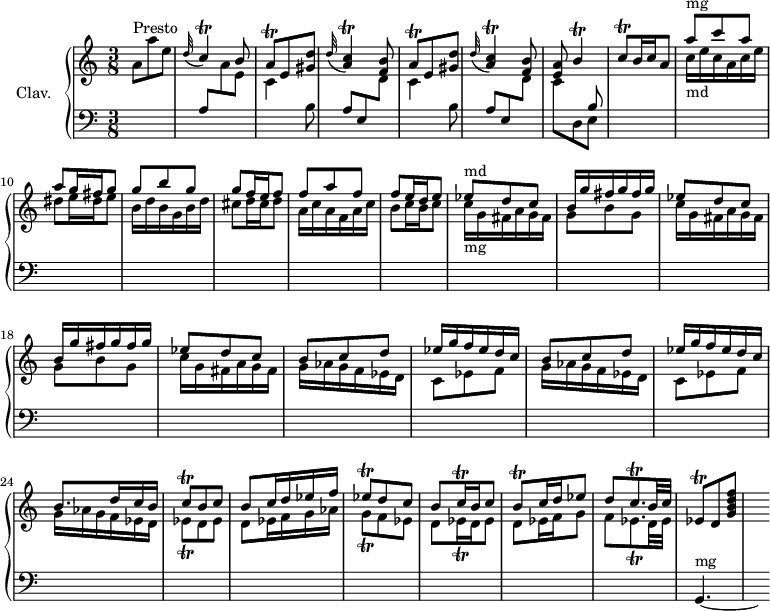Sonate K. 7
|
Sonate K.7 la mineur — ⋅ K.6 ← K.7 → K.8 ⋅ L.378 ← L.379 → L.380 ⋅ P.11 ← P.12 → P.13 ⋅ F.522 ← F.523 → F.524 —
⋅ R 17 ← Roseingrave 18 → R 19
⋅ 13 ← Cary 14 → 15
⋅ I 16 ← Boivin I 17 → I 18
|
La sonate K. 7 (F.523/L.379) en la mineur est une œuvre pour clavier du compositeur italien Domenico Scarlatti. C'est la septième sonate du seul recueil publié du vivant de l'auteur, les Essercizi per gravicembalo (1738) qui contient trente numéros.
Présentation[modifier | modifier le code]
La sonate en la mineur, K. 7, est notée Presto. Très difficile techniquement, certains motifs atteignent la plus haute virtuosité, telles les mesures 9 à 22 de la première section et 95 à 116, dans la seconde, qui se jouent en croisement de mains[1].

Édition[modifier | modifier le code]
L'œuvre est imprimée dans le recueil des Essercizi per gravicembalo publié sans doute à Londres en 1738[2].
-
Édition Amsterdam, 1742.
-
Édition Haslinger/Czerny, 1838.
Interprètes[modifier | modifier le code]
| Fichier audio | |
| Domenico Scarlatti, Sonate K. 7 | |
| modifier |
La sonate K. 7 est interprétée au piano notamment par Carlo Grante (2010, Music & Arts, vol. 1) ; au clavecin par Scott Ross (1976, Still et 1985, Erato)[3], Rafael Puyana (1988), Joseph Payne (BIS Records, 1990), Laura Alvini, Ottavio Dantone (2002, Stradivarius, vol. 8), Ottavio Dantone, Richard Lester (2004, Nimbus, vol. 1), Pieter-Jan Belder (Brilliant Classics), Kenneth Weiss (2007, Satirino) et Hank Knox (2021, Leaf Music).
Notes et références[modifier | modifier le code]
- Tranchefort 1987, p. 641.
- Kirkpatrick 1982, p. 420–421.
- Victor Tribot Laspière, « Au Château d’Assas, sur les traces de Scott Ross et de Scarlatti », sur France Musique, (consulté le )
Sources[modifier | modifier le code]
![]() : document utilisé comme source pour la rédaction de cet article.
: document utilisé comme source pour la rédaction de cet article.
- Ralph Kirkpatrick (trad. de l'anglais par Dennis Collins), Domenico Scarlatti, Paris, Lattès, coll. « Musique et Musiciens », (1re éd. 1953 (en)), 493 p. (OCLC 954954205, BNF 34689181).

- Alain de Chambure, « Domenico Scarlatti : Intégrale des sonates — Scott Ross », p. 172–175, Erato (2564-62092-2), 1985 (OCLC 891183737).

- François-René Tranchefort (dir.), Guide de la musique de piano et de clavecin, Paris, Fayard, coll. « Les Indispensables de la musique », , 578 p. (ISBN 978-2-213-01639-9, OCLC 17967083), p. 640–641.

Liens externes[modifier | modifier le code]
- Ressource relative à la musique :
- [vidéo] Sonate K. 7 (Kanji Daito, clavecin) sur YouTube



